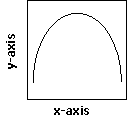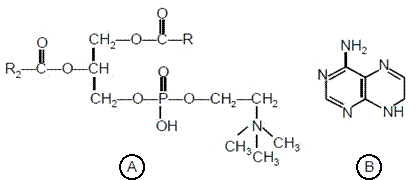NEET Biology, Class 11 MCQs | Biomolecules NEET Questions | Biomolecules MCQ | Biomolecules class 11 Question Bank | Biomolecules NEET MCQ | Biomolecules Biology NEET MCQ
Biomolecules: MCQs Quiz - 01
Congratulations - you have completed Biomolecules: MCQs Quiz - 01.
You scored %%SCORE%% out of %%TOTAL%%.
Your performance has been rated as %%RATING%%
Your answers are highlighted below.
Question 1 |
The curve given below show enzymatic activity with relation to three conditions (pH, temperature and substrate concentration). What do both axes (x and y) represent?


| x-axis | y-axis | |
| (1) | Enzymatic activity | Temperature |
| (2) | Enzymatic activity | pH |
| (3) | Temperature | Enzyme Activity |
| (4) | Substrate concentration | Enzymatic Activity |
Option (1) | |
Option (2) | |
Option (3) | |
Option (4) |
Question 2 |
Which one of the following structural formulae of two organic compounds is correctly identified along with its related function?


A : Lecithin - a component of cell membrane | |
B : Adenine - a nucleotide that makes up nucleic acids | |
A : Triglyceride - major source of energy | |
B : Uracil - a component of DNA |
Question 3 |
The ‘‘lock and key’’ model of enzyme action illustrates that a particular enzyme molecule
May be destroyed and resynthesised several times | |
Interacts with a specific type of substrate molecule | |
Reacts at identical rates under all conditions | |
Forms a permanent enzyme-substrate complex |
Question 4 |
One strand of DNA has the following sequence of nucleotide 3’ ATTCGCTAT 5’ so the other strand of DNA has
5’ TAAGCGATA 3’ | |
3’ TAAGCGATA 5’ | |
5’ GACGCGATA 3’ | |
3’ GACGCGATA 5’. |
Question 5 |
With reference to enzymes, which one of the following statements is true?
Apoenzyme = Holoenzyme + Coenzyme | |
Holoenzyme = Apoenzyme + Coenzyme | |
Coenzyme = Apoenzyme + Holoenzyme | |
Holoenzyme = Coenzyme – Apoenzyme |
Question 6 |
Feedback inhibition of enzymes is affected by which of the following
enzyme | |
substrate | |
end products | |
intermediate end products |
Question 7 |
Example of a typical homopolysaccharide is
Lignin | |
Suberin | |
Inulin | |
Starch |
Question 8 |
Which of the following is not a conjugated protein?
Peptone | |
Phosphoprotein | |
Lipoprotein | |
Chromoprotein |
Question 9 |
Chitin is a
Polysaccharide | |
Nitrogenous polysaccharide | |
Lipoprotein | |
Protein |
Question 10 |
Which one is diaminodicarboxylic amino acid?
Cystine | |
Lysine | |
Cysteine | |
Aspartic Acid |
Question 11 |
The effectiveness of an enzyme is affected least by
Temperature | |
Concentration of the substrate | |
Original activation energy of the system | |
Concentration of the enzyme |
Question 12 |
Which is an organic compound found in most cells?
Glucose | |
Water | |
Sodium chloride | |
Oxygen |
Question 13 |
Enzymes that catalyse inter-conversion of optical, geometrical or positional isomers are
Ligases | |
Lyases | |
Hydrolases | |
Isomerases |
Question 14 |
Fluidity of bio-membranes can be shown by
Electron microscope | |
Tissue culture | |
Phase-contrast microscope | |
Fluorescence microscope |
Question 15 |
The “Repeating Unit” of glycogen is
Fructose | |
Mannose | |
Glucose | |
Galactose |
Once you are finished, click the button below. Any items you have not completed will be marked incorrect.
There are 15 questions to complete.



this is a good method for our preparation. can we have the same method
for chemistry or physics.
this very intresting method for our preparation
weldone i had good time with laerning with mcqs
nice job learning is a life-time carrier and should be embraced
it denatures after a specific temp..
please explain question number 1
I have done a good practice with these mcq. Now no phobia with this chapter
at low temp enzymes are inactive.& high temp destroys enzymatic action bcz proteins denatured by heat..so ans is C..